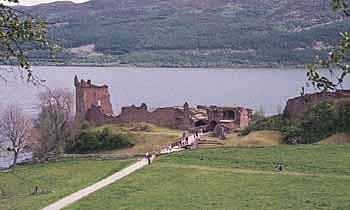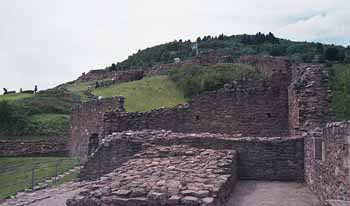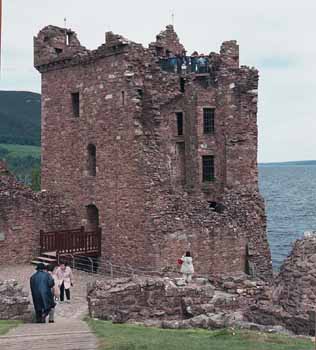
C a s t l e s
Travel Home
Travelogue
Planning
Resources
Itinerary
Scottish Castles
Abbeys and Kirks
Other sights
email Phouka
|
castle |


 We almost didn't stop here, because of the crowds. I'm glad we did. When we pulled up to the parking lot, there was a police officer directing traffic. Plus, we'd been driving by dozens of signs and plastic dinosaur replicas announcing that we had reached "Nessie Country." Traffic had been getting thicker all the way from Inverness. Not a particularly auspicious sign, but we manage to slip into a space and walk down to the castle grounds.
We almost didn't stop here, because of the crowds. I'm glad we did. When we pulled up to the parking lot, there was a police officer directing traffic. Plus, we'd been driving by dozens of signs and plastic dinosaur replicas announcing that we had reached "Nessie Country." Traffic had been getting thicker all the way from Inverness. Not a particularly auspicious sign, but we manage to slip into a space and walk down to the castle grounds.
Because of its location on Loch Ness, Urquhart is a well recognized castle, and it quite large. The walk down to the gates is steep, and we had the chance to listen to the piper (in full regalia) walking the parapet over the gatehouse. We arrived with a contingent of Japanese tourists, including a charming gentleman with lavender-colored hair and an older woman in full kimono.
Urquhart Castle was one of a chain of stronghlds garrisoning the Great Glen. The land route down the Great Glen was very important, and pieces of vitrified masonry on the highest part of the ruins suggest that there was a fortress here as early as the iron age. It was probably a wooden fortress or wall when the picts had a fort here in the 6th century. St. Columba may have visited the early fort here when he converted the pictish chief Enchatu to Christianity. This latest incarnation of Urquhart Castle was begun in the 13th century.
 The wall around the highest part of the castle was probably built by Alan Durward, Lord of Urquhart, in 1230. The upper and lower baileys were walled in by the Comyns in the 13th century, and the rest of the domestic buildings were added later. The castle held out for King David II in 1333 against Edward Balliol and Edward II of England.
The wall around the highest part of the castle was probably built by Alan Durward, Lord of Urquhart, in 1230. The upper and lower baileys were walled in by the Comyns in the 13th century, and the rest of the domestic buildings were added later. The castle held out for King David II in 1333 against Edward Balliol and Edward II of England.
Urquhart was held by the crown in 1346, and again in 1398, since Urquhart was deemed too important for any other than the King to hold during war. It was captured by the Lords of the Isles in 1452 after withstanding their attacks since 1437. The Lord of the Isles held the castle until 1456, when it was handed over to Huntly.
Urquhart was restored in 1509 by John Grant of Freuchie, who was granted the property by James IV, on the condition he restore the castle. It was plundered in 1545, and was reported as having ruinous walls as early as 1527.
By the early 17c, however, it was restored to comfortable accomodations. It was raided in 1644 by Covenanters, who took everything of value but left Lady Urquhart in possessionof the castle itself. Cromwell had a patrol boat on Loch Ness, so his forces probably occupied the castle, as well, instead of battering it to pieces with artillery. Urquhart was probably destroyed to prevent it from being used by the Jabobites in the 17th century. The local builders plundered the ruin for stone, and a report of Feb 1715 noted the collapse of the tower house in a gale. The remains continued to decay and be quarried until 1912.
The buildings are very ruined, and architectural details only exist on the tower. Dating is mostly guesswork. The gatehouse on the landward side gives access to a an interesting double bailey courtyard. On the seaward side, beyond the water gate are the basements of domestic range and on the left the 4 storied tower house.

The north end of the site has a tower roughly 6m square. At the south end was a two storye hall block. The grounds of the castle are roughly 150m. long. The lower bailey contained the domestic ranges, dating from 13/14c. This area would have included a large central hall, kitchen, and service areas.

